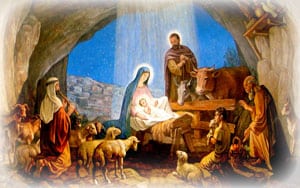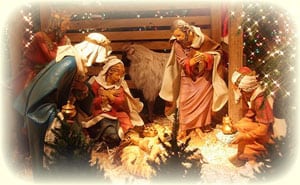ประวัติวันคริสต์มาส Christmas History

Christmas or Christmas Day is an annual holiday celebrated on December 25 that commemorates the birth of Jesus of Nazareth. The date of commemoration is not known to be Jesus’ actual birthday, and may have initially been chosen to correspond with either a historical Roman festival or the winter solstice. Christmas is central to the Christmas and holiday season, and in Christianity marks the beginning of the larger season of Christmastide, which lasts twelve days.
วันคริสต์มาสเป็นวันหยุดประจำปี ที่จัดขึ้นเพื่อเฉลิมฉลองการประสูติของพระเยซูซึ่งตรงกับวันที่ 25 ธันวาคม โดยวันดังกล่าวอาจจะไม่ตรงกับวันเกิดจริงๆของพระเยซู แต่อาจจะเป็นวันที่ถูกเลือกเอาไว้เพื่อให้สอดคล้องกับเทศกาลโรมัน หรือสอดคล้องกับวันที่มีช่วงเวลากลางวันสั้นที่สุด (winter solstice)คริสต์มาสเป็นเทศกาลที่สำคัญ และมีการฉลองอย่างยิ่งใหญ่ ในย่านของชาวคริสเตียนนั้นจะมีการจัดเทศกาลนี้ยาวนานถึง 12 วัน
Although traditionally a Christian holiday, Christmas is widely celebrated by many non-Christians, andsome of its popular celebratory customs have pre-Christian or secular themes and origins. Popular modern customsof the holiday include gift-giving, Christmas carols, an exchange of greeting cards, church celebrations, a special meal,and the display of various decorations; including Christmas trees, lights, and garlands, mistletoe, nativity scenes, and holly. In addition, Father Christmas (known as Santa Claus in North America and Ireland) is a popular mythological figure in many countries, associated with the bringing of gifts for children.
แม้ว่าวันคริสต์มาสจะเป็นเทศกาลของชาวคริสต์ แต่ในหมู่คนที่ไม่ใช่ชาวคริสต์ก็มีการเฉลิมฉลองกันอย่างแพร่หลายเช่นกัน ซึ่งการเฉลิมฉลองนั้นมีทั้งแบบสมัยใหม่ที่ไม่เกี่ยวข้องกับศาสนาเลยกับอีกแบบหนึ่งคือแบบดั้งเดิม โดยประเพณีที่เป็นนิยมในสมัยใหม่นั้น ได้แก่ การมอบของขวัญ การแลกเปลี่ยนการ์ดอวยพร
การจัดงานเลี้ยงฉลองในโบสถ์ การรับประทานอาหารมื้อพิเศษ และการโชว์งานตกแต่งประดับประดาตามสถานที่ต่าง ๆด้วย ต้นคริสต์มาส ดวงไฟประดับ พวงดอกไม้ ต้นมิสเซิลโท การแสดงเกี่ยวกับวันประสูติของพระเยซู และต้นฮอลลี่ นอกจากนี้บิดาแห่งคริสต์มาส (หรือที่ชาวอเมริกาเหนือและไอร์แลนด์เรียกว่า ซานตาคลอส) ยังเป็นหนึ่งตำนานที่เป็นที่รู้จักกันว่าเป็นผู้นำของขวัญมามอบให้กับเด็ก ๆ
Because gift-giving and many other aspects of the Christmas festival involve heightened economicactivity among both Christians and non-Christians, the holiday has become a significant event and a key sales period for retailers and businesses. The economic impact of Christmas is a factor that has grown steadily over the past few centuries in many regions of the world.
เนื่องจากการมอบของขวัญและการฉลองทั้งหลายนี้ ส่งผลต่อระบบเศรษฐกิจสูงมาก ทั้งในเมืองของชาวคริสเตียน และที่ไม่ใช่ชาวคริสเตียนเทศกาลคริสต์มาสจึงกลายเป็นช่วงเวลาที่สำคัญในการขายของสำหรับเหล่าพ่อค้าและนักธุรกิจการที่ระบบเศรษฐกิจได้รับการกระตุ้นจากเทศกาลนี้คือปัจจัยสำคัญที่ทำให้เกิดการเติบโตอย่างต่อเนื่องในทั่วทุกพื้นที่ในช่วง 2-3 ศตวรรษที่ผ่านมานี้

ที่มาของคำว่า คริสต์มาส
The word Christmas originated as a compound meaning “Christ’s Mass”. It is derived from the Middle English Christemasse and Old English Cristes mæsse, a phrase first recorded in 1038. “Cristes” is from Greek Christos and “mæsse” is from Latin missa. In Greek, the letter (chi), is the first letter of Christ, and it, or the similar Roman letter X, has been used as an abbreviation for Christ since the mid-16th century. Hence, Xmas is often used as an abbreviation for Christmas.
คำว่า คริสต์มาส มีที่มาจากคำประสม คำว่า “Christ’s Mass” ซึ่งมีรากคำมาจากคำว่า Christemasse ของภาษาอังกฤษยุคกลาง และ คำว่า Cristes mæsse จากภาษาอังกฤษโบราณซึ่งมีการบันทึกคำดังกล่าวครั้งแรกไว้ในปี 1038
คำว่า Cristes มาจากพระเยซูคริสต์ของกรีก และคำว่า mæsse มาจากหนังสือสวดมนตร์ของชาวละติน ในภาษากรีกตัวอักษร X เป็นตัวอักษรแรกของคำว่า “Christ” ซึ่งคล้ายกับตัว X ในภาษาโรมัน จึงมีการใช้ X แทน Christ ตั้งแต่กลางศตวรรษที่ 16 ดังนั้นจึงนิยมใช้คำว่า Xmas แทน Christmas

ประวัติคริสต์มาส

For many centuries, Christian writers accepted that Christmas was the actual date on which Jesus was born. However, in the early eighteenth century, scholars began proposing alternative explanations. Isaac Newton argued that the date of Christmas was selected to correspond with the winter solstice, which in ancient times was marked on December 25. In 1743, German Protestant Paul Ernst Jablonski argued Christmas was placed on December 25 to correspond with the Roman solar holiday Dies Natalis Solis Invicti and was therefore a “paganization” that debased the true church. In 1889, Louis Duchesne suggested that the date of Christmas was calculated as nine months after the Annunciation (March 25), the traditional date of the Incarnation.
เป็นเวลาหลายศตวรรษที่นักเขียนชาวคริสเตียนยอมรับว่าวันคริสต์มาสนั้นตรงกับวันประสูติของพระเยซู อย่างไรก็ตาม ในช่วงต้นศตวรรษที่ 18 ก็เริ่มมีนักวิชาการนำเสนอคำอธิบายเพิ่มเติม ไอแซค นิวตัน ให้ความเห็นว่าวันคริสต์มาสนั้นถูกเลือกขึ้นมาเพื่อให้สอดคล้องกับช่วง วันที่มีกลางวันสั้นที่สุด (winter solstice) ซึ่งในอดีตได้กำหนดไว้ให้ตรงกับวันที่ 25 ธันวาคม
ปี 1743 Paul Ernst Jablonski ชาวเยอรมันที่นับถือคริสต์นิกายโปแตสแตนซ์ ให้ความเห็นว่าวันคริสต์มาสนั้นระบุให้ตรงกับวันที่ 25 ธันวาคม เพื่อให้สอดคล้องกับวันหยุด Roman Solar Holiday Dies Natalis Solis Invicti และโดยเหตุการณ์นั้น พวกนอกรีตได้ทำให้โบสถ์ดูไม่น่าเลื่อมใส และหมดความศรัทธา
ปี 1889 Louis Duchesne กล่าวว่าวันคริสต์มาสถูกคำนวณจากวัน Annunciation ไปอีก 9 เดือน วัน Annunciation ตรงกับวันที่ 25 มีนาคม ซึ่งเป็นวันที่ระลึกถึงการกลับชาติมาเกิดของนางฟ้ากาเบรียล ซึ่งจุติเป็นพระแม่มารี ซึ่งตามประเพณีแล้วถือว่าเป็นวันแห่งการลงมาจุติยังโลกมนุษย์

Pre-Christian background
Dies Natalis Solis Invicti means “the birthday of the unconquered Sun.” The use of the title Sol Invictus allowed several solar deities to be worshipped collectively, including Elah-Gabal, a Syrian sun god; Sol, the god of Emperor Aurelian; and Mithras, a soldiers’ god of Persian origin. Emperor Elagabalus (218–222) introduced the festival, and it reached the height of its popularity under Aurelian, who promoted it as an empire-wide holiday. This day had held no significance in the Roman festive calendar until it was introduced in the third century.
Dies Natalis Solis Invicti หมายความว่า “วันเกิดของเทพเจ้าแห่งพระอาทิตย์ ผู้ที่ไม่มีใครเอาชนะได้” การใช้คำนำหน้า Sol Invictus จะอนุญาตให้ใช้กับเทพแห่งดวงอาทิตย์ที่ได้รับการให้ความเคารพในชนหมู่มาก ได้แก่ Elah-Gabal, เทพแห่งดวงอาทิตย์ของชาวซีเรีย Sol เทพซึ่งเป็นจักรพรรดิของชาว Aurelian และ Mithras องครักษ์เทพของชาวเปอร์เซียพื้นเมือง จักรพรรดิ Elagabalus (ปี 218-222) เป็นผู้นำเอาประเพณีนี้เข้ามา ซึ่งได้รับความนิยมมากในหมู่ชาว Aurelian ซึ่งต่อมาได้กลายมาเป็นวันหยุดประจำราชอาณาจักร แต่เทศกาลนี้ก็ไม่ได้รับการระบุลงในปฏิทินเทศกาลของโรมัน จนกระทั่งศตวรรษที่ 3 Dies Natalis Solis Invicti
The festival was placed on the date of the solstice because this was on this day that the Sun reversed its southward retreat and proved itself to be “unconquered.”Several early Christian writers connected the rebirth of the sun to the birth of Jesus. “O, how wonderfully acted Providence that on that day on which that Sun was born…Christ should be born”, Cyprian wrote. John Chrysostom also commented on the connection: “They call it the ‘Birthday of the Unconquered’. Who indeed is so unconquered as Our Lord . . .?”
เทศกาลนี้ถูกระบุลงในวันที่กลางวันสั้นที่สุด เพราะเป็นวันที่ดวงอาทิตย์หมุนกลับไปทางใต้เพื่อจะพิสูจน์ถึงการ “ไม่อาจเอาชนะได้” ซึ่งนักเขียนชาวคริสเตียนหลายคนได้เชื่อมเอาการกลับมาของดวงอาทิตย์ไปโยงกับการประสูติขององค์พระเยซู Cyprian ได้เขียนเอาไว้ว่า “การกำเนิดของดวงอาทิตย์ช่างงดงาม….พระเยซูคริสต์เองก็ควรประสูติในวันเช่นนี้” John Chrysostom เองก็ได้เขียนเอาไว้เช่นกันว่า “พวกเขาเรียกวันนั้นว่า วันเกิดของผู้ที่ไม่มีใครเอาชนะได้ แล้วใครกันที่จะไม่มีวันพ่าย หากไม่ใช่พระผู้เป็นเจ้า”

เทศกาลฤดูหนาว
A winter festival was the most popular festival of the year inmany cultures. Reasons included the fact that less agricultural workneeds to be done during the winter, as well as an expectation of better weather as spring approached. Modern Christmas customs include: gift-giving and merrymaking from Roman Saturnalia; greenery, lights, and charity from the Roman New Year; and Yule logs and various foods from Germanic feasts. Pagan Scandinavia celebrated a winter festival called Yule, held in the late December to early January period. As Northern Europe was the last part to Christianize, its pagan traditions had a major influence on Christmas. Scandinavians still call Christmas Jul. In English, the word Yule is synonymous with Christmas, a usage first recorded in 900.
เทศกาลฤดูหนาวคือเทศกาลที่ประชาชนให้ความนิยมสูงสุดกันมาช้านานในหลายประเทศด้วยเหตุผลหลายประการ รวมถึงงานด้านเกษตรกรรมมีไม่มากนักในช่วงฤดูหนาวและเพราะการตั้งความหวังว่าสภาพอากาศจะดีขึ้นเมื่อฤดูใบไม้ผลิแวะเวียนมาถึงกิจกรรมของคริสต์มาสสมัยใหม่นั้น ประกอบด้วย การมอบของขวัญ การเฉลิมฉลองเพื่อบูชาเทพเจ้าของชาวโรมันการประดับสถานที่ด้วยพืชพันธุ์สีเขียวและแสงไฟ รวมถึงงานการกุศลในวันปีใหม่ของชาวโรมันการก่อกองไฟจากท่อนไม้ขนาดใหญ่ และสำหรับชาวเยอรมันจะมีการเลี้ยงฉลองด้วยอากหารหลากชนิดปฏิทินของชาวเพเกน สแกนดิเนียเวีย ฉลองเทศกาลฤดูหนาวโดยใช้ชื่อว่า ยูล ซึ่งจะจัดขึ้นในปลายเดือนธันวาคมถึงต้นเดือนมกราคม เนื่องจากทางตอนเหนือของยุโรปเป็นพื้นที่ท้ายๆที่นับถือศาสนาคริสต์ ซึ่งวัฒนธรรมเพเกนเองก็ได้รับอิทธิพลมาจากวันคริสต์มาสชาวสแกนดิเนเวียนยังคงเรียกวันคริสต์มาสว่า คริสต์มาส จูล ในภาษาอังกฤษคำว่ายูลนั้นมีความหมายเหมือนกับคำว่าคริสต์มาส ซึ่งมีการบันทึกการใช้ครั้งแรกในปี 900

ความเป็นมาของผู้ที่นับถือศาสนาคริสต์
The New Testament does not give a date for the birth of Jesus. Around AD 200, Clement of Alexandria wrote that a group in Egypt celebrated the nativity on Pachon 25. This corresponds to May 20. Tertullian (d. 220) does not mention Christmas as a major feast day in the Church of Roman Africa.
However, in Chronographai, a reference work published in 221, Sextus Julius Africanus suggested that Jesus was conceived on the spring equinox, popularizing the idea that Christ was born on December 25. The equinox was March 25 on the Roman calendar, so this implied a birth in December. De Pascha Computus, a calendar of feasts produced in 243, gives March 28 as the date of the nativity. In 245, the theologian Origen of Alexandria stated that, “only sinners (like Pharaoh and Herod)” celebrated their birthdays. In 303, Christian writer Arnobius ridiculed the idea of celebrating the birthdays of gods, which suggests that Christmas was not yet a feast at this time.
พระคัมภีร์ไบเบิลเล่มใหม่ไม่ได้ระบุถึงวันประสูติของพระเยซู ซึ่งประมาณปีคริสต์ศักราชที่ 200จากความเมตตาของพระเจ้าอเล็กซานเดอร์ ทำให้ชนชาวอิยิปเฉลิมฉลองเทศกาลงานคล้ายวันประสูติที่ Pachon 25 ได้ ซึ่งตรงกับวันที่ 20 พฤษภาคม
ชนชาว Tertullian เมื่อคริสต์ศักราชที่ 220 ไม่ได้เอ่ยถึงความสำคัญของเทศกาลคริสต์มาสที่มีผลกระทบอย่างมากต่องานวันเฉลิมฉลองที่จัดขึ้นในโบสถ์ของชาวโรมัน – แอฟริกา

อย่างไรก็ตาม ใน Chronographai หนังสืออ้างอิงซึ่งได้เผยแพร่ในปี 221, Sextus Julius Africanusได้บรรยายไว้ว่า การตั้งครรภ์พระเยซู เกิดขึ้นในฤดูใบไม้ผลิ ของวันที่กลางวันและกลางคืนยาวเท่ากัน ดังนั้น จึงเกิดความคิดที่แพร่หลายกันว่าพระเยซูประสูติในวันที่ 25 ธันวาคม ซึ่งวันที่กลางวันและกลางคืนยาวเท่ากันตามปฏิทินของชาวโรมันนั้น คือวันที่ 25 มีนาคมทำให้เกิดความเข้าใจกันว่าการประสูติจะอยู่ในเดือนธันวาคม
De Pascha Computus คือปฏิทินของวันเฉลิมฉลอง จัดทำขึ้นในปี 243 ได้ระบุให้วันที่ 28 มีนาคม เป็นวันแห่งการกำเนิดของพระเยซู ในปี 245 นักเทววิทยา Origen of Alexandria ได้เปิดประเด็นว่ามีแต่คนบาปเท่านั้น (เช่น ฟาร์โร และเฮร็อด) ที่เฉลิมฉลองวันเกิดของตนเอง ในปี 303 นักเขียนคริสเตียนที่ชื่อ Arnobius เยาะเย้ยความคิดในเรื่องการเฉลิมฉลองวันประสูติของพระผู้เป็นเจ้า ซึ่งเขาได้แนะนำว่าวันคริสต์มาสไม่ใช่ช่วงเวลาที่เหมาะสมในการจัดงานเฉลิมฉลอง

จุดเริ่มต้นของเทศกาล
An early reference to the date of the nativity as December 25 is found in the Chronography of 354, an illuminated manuscript compiled in Rome in 354. In the East, early Christians celebrated the birth of Christ as part of Epiphany (January 6), although this festival emphasized celebration of the baptism of Jesus.
Christmas was promoted in the Christian East as part of the revival of Catholicism following the death of the pro-Arian Emperor Valens at the Battle of Adrianople in 378. The feast was introduced to Constantinople in 379, and to Antioch in about 380. The feast disappeared after Gregory of Nazianzus resigned as bishop in 381, although it was reintroduced by John Chrysostom in about 400.
มีการค้นพบเอกสารที่อ้างอิงว่าพระเยซูประสูติในวันที่ 25 ธันวาคม ใน the Chronography of 354 ซึ่งเป็นต้นฉบับที่รวบรวมไว้ในกรุงโรมเมื่อปี 354 ชาวคริสต์ทางตะวันออกจะถือเอาการเฉลิมฉลองวันประสูติของพระเยซูเป็น ส่วนหนึ่งของวัน Epiphany (6 มกราคม) แม้ว่าวัน Epiphany นี้ จะเน้นที่พิธีกรรมการล้างบาปก็ตาม
เทศกาลคริสต์มาสเป็นที่รู้จักของชาวคริสเตียนตะวันออกในส่วนของการฟื้นฟู ศาสนาคริสต์นิกายโรมันคาทอลิกขึ้นมาใหม่ หลังจากการสิ้นพระชนม์ของจักรพรรดิ Arian Emperor Valens ที่สมรภูมิ Adrianople ในปี 378 การฉลองเริ่มเป็นที่รู้จักในเมือง Constantinople เมื่อปี 379 และเมือง Antioch ในปี 380 แล้วประเพณีการเฉลิมฉลองก็เลือนหายไปหลังจากที่ Gregory แห่ง Nazianzus ลาออกจากตำแหน่งบิช็อปในปี 381 และก็ถูก John Chrysostom นำกลับมาเผยแพร่อีกครั้งในช่วงปี 400

ในช่วงยุคกลาง
In the Early Middle Ages, Christmas Day was overshadowed by Epiphany, which in the west focused on the visit of the magi. But the Medieval calendar was dominated by Christmas-related holidays. The forty days before Christmas became the “forty days of St. Martin” (which began on November 11, the Afeast of St. Martin of Tours), now known as Advent. In Italy, former Saturnalian traditions were attached to Advent. Around the 12th century, these traditions transferred again to the Twelve Days of Christmas (December 25 – January 5); a time that appears in the liturgical calendars as Christmastide or Twelve Holy Days.
ยุคกลาง
ในช่วงแรกของยุคกลางนั้นเทศกาลคริสต์มาสถูกลดความสำคัญลงเนื่องจากวัน Epiphany เพราะชาวตะวันตกมุ่งความสนใจให้กับการเข้ามาของพวกมากิ (นักแสวงบุญ) แต่ในปฏิทินของยุคกลางกลับระบุถึงเทศกาลที่เกี่ยวกับวันคริสต์มาส สี่สิบวันก่อนถึงวันคริสต์มาสกลับกลายมาเป็น“สี่สิบวันของเซ็นต์มาร์ติน” (งานฉลองเซ็นต์มาร์ตินจะเริ่มจากวันที่ 11 พฤศจิกายน) ซึ่งปัจจุบันรู้จักกันในชื่อ “Advent”
ในประเทศอิตาลี ประเพณีบูชาพระเจ้าในอดีตถูกรวมให้ปฏิบัติกิจกรรมในวัน “Advent” ด้วยเช่นกัน ราวศตวรรษที่ 12 ประเพณีนี้ถูกย้ายไปอยู่ใน “12 วันแห่งคริสต์มาส” (25 ธันวาคม – 5 มกราคม) ช่วงเวลาดังกล่าว ถูกระบุเอาไว้ในปฏิทินว่าเป็นช่วง “Christmastide” หรือสิบสองวันศักดิ์สิทธิ์
The prominence of Christmas Day increased gradually after Charlemagne was crowned Emperor on Christmas Day in 800. King Edmund the Martyr was anointed on Christmas in 855 and King William I of England was crowned on Christmas Day 1066.
ความสำคัญของวันคริสต์มาสเพิ่มมากขึ้นเมื่อ Charlemagne ได้ครองตำแหน่งจักรพรรดิในวันคริสต์มาสในปี 800 ส่วนกษัตริย์ Edmund the Martyr ได้รับการแต่งตั้งเมื่อวันคริสต์มาสปี 855 และกษัตริย์วิลเลี่ยมที่ 1 แห่งอังกฤษได้รับตำแหน่งจักรพรรดิในวันคริสต์มาสปี 1066
By the High Middle Ages, the holiday had become so prominent that chroniclers routinely noted where various magnates celebrated Christmas. King Richard II of England hosted a Christmas feast in 1377 at which twenty-eight oxen and three hundred sheep were eaten. The Yule boar was a common feature of medieval Christmas feasts. Caroling also became popular, and was originally a group of dancers who sang. The group was composed of a lead singer and a ring of dancers that provided the chorus. Various writers of the time condemned caroling as lewd, indicating that the unruly traditions of Saturnalia and Yule may have continued in this form. “Misrule”—drunkenness, promiscuity, gambling—was also an important aspect of the festival. In England, gifts were exchanged on New Year’s Day, and there was special Christmas ale.
คริสต์มาสกลายมาเป็นเทศกาลที่มีการเฉลิมฉลองเป็นประจำในยุครุ่งเรืองของสมัยกลางซึ่งมักมีบุคคลสำคัญฉลองเทศกาลนี้ โดยกษัตริย์ริชาร์ตที่ 2 แห่งอังกฤษได้จัดงานเลี้ยงคริสต์มาสในปี 1377ซึ่งในงานมีการกินเลี้ยงวัวยี่สิบแปดตัว และแกะอีกสามร้อยตัว
หมูป่าประจำวันคริสต์มาสถือเป็นสัญลักษณ์ของงานฉลองคริสต์มาสในยุคกลางการร้องประสานเสียงเริ่มได้ความนิยมมากขึ้น แล้วก็เป็นจุดเริ่มต้นของนักเต้นซึ่งสมาชิกก็มาจากกลุ่มนักร้องประสานเสียงนั่นเอง โดยวงจะประกอบไปด้วยนักร้องนำและมีนักเต้นซึ่งจะล้อมรอบนักร้องนำเป็นผู้ร้องประสานเสียงด้วย นักเขียนหลายคนในยุคนั้นวิจารณ์นักร้องประสานเสียงนั้นว่าเต็มไปด้วยตัณหา และชี้ให้เห็นว่า ประเพณีการบูชาเทพเจ้าที่ไร้วินัยแบบนี้จะยังคงเป็นอยู่แบบนี้ไปเรื่อย ๆการทำผิดกฎ ขี้เหล้าเมายา การผิดประเวณี และเล่นการพนัน กลายเป็นส่วนสำคัญของกิจกรรมงานฉลองในอังกฤษมีการแลกเปลี่ยนของขวัญในวันปีใหม่ ซึ่งก็มีการแลกเปลี่ยนเครื่องดื่มที่มีแอลกอฮอล์สำหรับวันคริสต์มาสในวันนั้นด้วย
Christmas during the Middle Ages was a public festival that incorporating ivy, holly, and other evergreens. Christmas gift-giving during the Middle Ages was usually between people with legal relationships, such as tenant and landlord. The annual indulgence in eating, dancing, singing, sporting, card playing escalated in England, and by the 17th century the Christmas season featured lavish dinners, elaborate masques and pageants. In 1607, King James I insisted that a play be acted on Christmas night and that the court indulge in games.

เทศกาลคริสต์มาสในช่วงยุคกลางเป็นเทศกาลระดับชาติที่รวมเอาไม้เลื้อย ต้นฮอลลีและพืชใบเขียวอื่นๆมาประดับตกแต่งตามสถานที่ต่างๆ แต่ว่าการแลกของขวัญคริสต์มาสในยุคกลางนั้นจะมีก็แต่เฉพาะกลุ่มคนที่มีความสัมพันธ์กันทางกฎหมายเท่านั้น เช่น ผู้เช่ากับผู้ให้เช่า ในอังกฤษเริ่มมีการจัดงานเลี้ยง งานร้องรำทำเพลง เล่นกีฬา หรือเกมส์ไพ่มากขึ้นเรื่อยๆ จนกระทั่งศตวรรษที่ 17 เทศกาลคริสต์มาสก็เริ่มมีงานเลี้ยงที่หรูหรา ฟุ่มเฟือยและการประกวดหน้ากาก, ในปี 1607 กษัตริย์เจมส์ที่ 1 ก็ยืนกรานให้มีการเล่นละครในคืนวันคริสต์มาส ซึ่งกระบวนการทางศาลก็ยอมผ่อนผันให้สามารถเล่นได้

การปฏิรูปสู่ศตวรรษที่ 19
Following the Protestant Reformation, groups such as the Puritans strongly condemned the celebration of Christmas, considering it a Catholic invention and the “trappings of popery” or the “rags of the Beast.” The Catholic Church responded by promoting the festival in a more religiously oriented form. King Charles I of England directed his noblemen and gentry to return to their landed estates in midwinter to keep up their old style Christmas generosity. Following the Parliamentarian victory over Charles I during the English Civil War,England’s Puritan rulers banned Christmas in 1647. Protests followed as pro-Christmas rioting broke out in several cities and for weeks Canterbury was controlled by the rioters, who decorated doorways with holly and shouted royalist slogans. The book, The Vindication of Christmas (London, 1652), argued against the Puritans, and makes note of Old English Christmas traditions, dinner, roast apples on the fire, card playing, dances with “plow-boys” and “maidservants”, and carol singing. The Restoration of King Charles II in 1660 ended the ban, but many clergymen still disapproved of Christmas celebration. In Scotland, the Presbyterian Church of Scotland also discouraged observance of Christmas. James VI commanded its celebration in 1618, however attendance at church was scant.
ในระหว่างการปฏิรูปของนิกายโปรแตสแต้นท์ กลุ่มคนที่เคร่งครัดในศีลธรรมได้วิจารณ์ว่าการฉลองเทศกาลคริสต์มาสของชาวคาทอลิกว่า เป็นเหมือน “คำสอนที่เป็นได้แค่เครื่องประกอบ” และ “ความเดือดดาลของสัตว์ร้าย” ดังนั้นโบสถ์นิกายโรมันคาทอลิกได้ส่งเสริมให้เทศกาลนี้น่าเลื่อมใสมากขึ้นโดยเน้นพิธีกรรมทางศาสนามากขึ้น จากนั้น กษัตริย์ชาลส์ที่ 1 ได้สั่งการให้เหล่าขุนนางและชนชั้นสูงกลับบ้านเกิดในช่วงกลางฤดูหนาวเพื่อคงไว้ซึ่งประเพณีดั้งเดิมของวันคริสต์มาส
จากชัยชนะของฝ่ายรัฐสภาเหนือฝ่ายกษัตริย์ชาลส์ที่ 1 ในสงครามกลางเมืองในปี 1647ประมุขของกลุ่มผู้เคร่งครัดในศาสนาก็ได้ยกเลิกเทศกาลนี้ และสิ่งที่ตามมาก็คือเกิดก่อจลาจลจากผู้ต่อต้านในหลายเมือง และประมาณหนึ่งสัปดาห์ต่อมาเมืองแคนเทอบิวรี่ก็ตกอยู่ในความควบคุมของกลุ่มผู้ก่อการจลาจล ซึ่งพวกเขาได้ตกแต่งทางเข้าออกด้วยดอกฮอลลิ และคอยตะโกนกล่าวคำสรรเสริญกษัตริย์ของพวกเขายังมีข้อความในหนังสือ The Vindication of Christmas (London, 1652) ที่โต้แย้งกลุ่มผู้เคร่งครัดทางศาสนา และบันทึกประเพณีการฉลองคริสต์มาสแบบเก่าของอังกฤษซึ่งประกอบด้วย การทานอาหารค่ำ การปิ้งแอปเปิ้ล เล่นไพ่ การเต้นรำกับเด็กชายท้องนาและสาวรับใช้ และร่วมร้องเพลงประสานเสียง จนมาถึงปี 1660 ในยุคฟื้นฟูสมัยของกษัตริย์ชาลส์ที่ 2 การยกเลิกงานเทศกาลก็สิ้นสุดลง แต่พวกนักบวชก็ยังคงไม่ยอมรับการเฉลิมฉลอง ในประเทศสก็อตแลนด์ โบสถ์ของชาวโปรแตสแตนท์นั้นไม่เห็นด้วยการการเฉลิมฉลองนี้เหมือนกัน กษัตริย์เจมส์ที่หกได้สั่งให้มีการจัดงานฉลองคริสต์มาสต์แต่กลับมีผู้มาร่วมงานน้อย
In Colonial America, the Puritans of New England shared radical protestant disapproval of Christmas. Celebration was outlawed in Boston from 1659 to 1681. The ban by the Pilgrims was revoked in 1681 by English governor Sir Edmund Andros, however it wasn’t until the mid 1800’s that celebrating Christmas became fashionable in the Boston region. At the same time, Christian residents of Virginia and New Yorkobserved the holiday freely. Pennsylvania German Settlers, pre-eminently the Moravian settlers of Bethlehem, Nazareth and Lititz in Pennsylvania and the Wachovia Settlements in North Carolina, were enthusiastic celebrators of Christmas. The Moravians in Bethlehem had the first Christmas trees in America as well as the first Nativity Scenes. Christmas fell out of favor in the United States after the American Revolution, when it was considered an English custom. George Washington attacked Hessian mercenaries on Christmas during the Battle of Trenton in 1777. (Christmas being much more popular in Germany than in America at this time.)
รัฐปูริตานส์แห่งนิว อิงแลนด์ อาณานิคมของอเมริกา ได้ถูกพวกเคร่งศาสนานิกายโปรแตสแต้นท์ขัดขวางและต่อต้านงานเทศกาล แต่ในปี 1659 ถึง 1681 มีการฉลองอย่างผิดกฎหมายในเมืองบอสตันซึ่งต่อมาการขัดขางและต่อต้านนี้ ได้ถูกยกเลิกโดยผู้ว่าการชาวอังกฤษชื่อ Sir Edmund Andros ในปี 1681 อย่างไรก็ตามงานฉลองประเพณีคริสต์มาสก็ยังไม่ได้รับการตอบรับเท่าที่ควรจนกระทั่งกลางปีที่ 1800 ความนิยมในเทศกาลนี้ถึงกระจายไปทั่วพื้นที่ของเมืองบอสตัน ในเวลาเดียวกัน ชาวคริสเตียนในเวอร์จีเนียและนิวยอร์กต่างได้รับอิสระในการฉลองประเพณีนี้ผู้ตั้งถิ่นฐานชาวเยอรมันในเมืองเพนซิวาเนีย, ชาวโมราเวียนซึ่งมีอยู่น้อยมากในเมืองเบธเลเฮม, ชาวนาซาเรซ และลิทิซ ในเมืองเพนซิวาเนีย และ ชาววาโชเวียในนอร์ท คาโรไรน่าตื่นตัวมากที่จะได้ฉลองกับเทศกาลคริสต์มาส, ชาวโมราเวียนในเมืองเบธเลเฮมมีต้นคริสต์มาสต้นแรกของอเมริกาเช่นเดียวกับฉากการประสูติของพระเยซูก็เกิดขึ้นครั้งแรกที่นี่แต่หลังจากการปฏิวัติอเมริกา เทศกาลคริสต์มาสก็เริ่มเสื่อมความนิยมลงเมื่อทุกคนต่างลงความเห็นว่าคริสต์มาสเป็นเทศกาลของชาวอังกฤษ ปี 1777 จอร์จ วอชิงตันได้โจมตีกลุ่มพ่อค้าชาวเฮซเซียนในวันคริสต์มาสในสมรภูมิ the Battle of Trenton (ในช่วงเวลานี้เทศกาลคริสต์มาสเป็นที่นิยมในเยอรมันมากกว่าอเมริกา)
By the 1820s, sectarian tension had eased in Britain and writers, including William Winstanly, began to worry that Christmas was dying out. These writers imagined Tudor Christmas as a time of heartfelt celebration, and efforts were made to revive the holiday. Charles Dickens’ novel A Christmas Carol, published in 1843, helped revive the ‘spirit’ of Christmas and seasonal merriment. Its instant popularity played a major role in portraying Christmas as a holiday emphasizing family, goodwill, and compassion. Prominent phrases in Dickens’ Yultide tale, ‘Bah! Humbug!’, and ‘Merry Christmas’, grew in usage in the English language. Also in 1843, the first Christmas card was produced by Sir Henry Cole. The revival of the Christmas Carol began with William B. Sandys Christmas Carols Ancient and Modern (1833), with the first appearance in print of ‘The First Noel’, ‘I Saw Three Ships’, ‘Hark the Herald Angels Sing’ and ‘God Rest Ye Merry, Gentlemen’, popularized in Dickens’ A Christmas Carol. Other English carols such as ‘We Wish You A Merry Christmas’ and ‘Oh Come All Ye Faithful’ also grew in popularity. Singing carols in church was later instituted on Christmas Eve 1880 (Nine Lessons and Carols) in Truro Cathedral, Cornwall, England, which is now seen in churches all over the world.
ราวช่วงทศวรรษที่ 1820 ความเข้มงวดของลัทธิต่าง ๆ ในสหราชอาณาจักรเริ่มเสื่อมลงนักเขียนทั้งหลายรวมถึงวิลเลียม วินสแตนลี เริ่มกังวลว่าคริสต์มาสจะสูญสลายไปพวกนักเขียนจินตนาการว่าเทศกาลคริสต์มาสคือเวลาแห่งการเฉลิมฉลอง และได้พยายามกระทำวิธีการต่าง ๆเพื่อฟื้นฟูเทศกาลนี้ จนกระทั่งเมื่อนวนิยายเรื่อง A Christmas Carol ของ Charles Dickens ได้ถูกตีพิมพ์ในปี 1843 ซึ่งช่วยฟื้นฟูจิตวิญญาณแห่งวันคริสต์มาสและเทศกาลแห่งความรื่นเริงคริสต์มาสจึงเริ่มกลับมามีบทบาทสำคัญเพราะเป็นเทศกาลที่เน้นความสำคัญของครอบครัวความปราถนาดี และความเห็นอกเห็นใจ
มีการนำประโยคเด่นในนิยายของ Dicken ที่ว่า Bah! Humbug!’ และ ‘Merry Christmas’ มาใช้ในภาษาอังกฤษ และในปี 1843 การ์ดอวยพรวันคริสต์มาสใบแรกก็ถูกผลิตขึ้นมาโดย เซอร์ เฮนรี่ โคลย์ เพลงประสานเสียงคริสต์มาสเริ่มถูกฟื้นฟูกลับมาโดย วิลเลียม บี แซนดี้ส์ จากบทความเรื่อง William B. Sandys Christmas Carols Ancient and Modern (1833) ซึ่งตีพิมพ์ครั้งแรกใน ‘The First Noel’, ‘I Saw Three Ships’, ‘Hark the Herald Angels Sing’ และ ‘God Rest Ye Merry, Gentlemen’ ที่โด่งดังในหนังสือ A Christmas Carol ของ Dickens และเพลงประสานเสียงอื่นๆของอังกฤษก็ได้รับความนิยมเช่น ‘We Wish You A Merry Christmas’ และ ‘Oh Come All Ye Faithful’
การร้องเพลงประสานเสียงในโบสถ์ในคืนก่อนวันคริสต์มาสเริ่มมีมาตั้งแต่ ปี 1880 ในเมือง ทรูโร แคธีดรอล รัฐคอนวอล ประเทศอังกฤษ (คำกลอน และ เพลงร้องประสานเสียงอย่างละ 9 บท) ซึ่งปัจจุบันสามารถพบเห็นกิจกรรมดังกล่าวได้ในทุกโบสถ์ทั่วโลก
In Britain, the Christmas tree was introduced in the early 1800’s at the time of the personal union with Hanover, by Charlotte of Mecklenburg-Strelitz,Queen to King George III, but the custom did not immediately spread far beyond the royal family. After Queen Victoria’s marriage to her German cousin, Prince Albert, by 1841 the custom became more widespread throughout Britain. A powerful image of the British Royal family with their Christmas tree at Windsor Castle, initially published in the Illustrated London News December 1848, was copied in the United States at Christmas 1850, in Godey’s Lady’s Book (illustration, right). Godey’s copied it exactly, except removed the Queens crown, and Prince Alberts moustache, to remake the engraving into an American scene. The republished Godey’s image in 1850, the first widely circulated picture of a decorated evergreen Christmas tree in America, the Art historian Karal Ann Marling called “the first influential American Christmas tree”. Folk-culture historian Alfred Lewis Shoemaker states; “In all of America there was no more important medium in spreading the Christmas tree in the decade 1850-60 than Godey’s Lady’s Book”. The image was reprinted in 1860, and by the 1870s, putting up a Christmas tree had become common in America.
ในประเทศอังกฤษ ต้นคริสต์มาสได้ถูกนำเข้ามาเผยแพร่ในตอนต้นปี 1800 ในช่วงที่ราชินี Charlotte of Mecklenburg-Strelitz ราชินีแห่งกษัตริย์จอร์จที่ 3 ไปเยือนที่เมืองฮันโนเวอร์เป็นการส่วนพระองค์แต่ประเพณีดังกล่าวกลับไม่ได้รับความนิยมจากเจ้าฟ้าในราชวงค์มากนัก หลังจากที่พระนางวิคตอเรียอภิเสกสมรสกับเจ้าชายอัลเบิร์ท พระญาติชาวเยอรมันของพระองค์ในปี 1841 ประเพณีการตกแต่งต้นคริสต์มาสก็ขยายวงกว้างออกไปทั่วประเทศ ภาพลักษณ์ของราชวงศ์อังกฤษกับต้นคริสต์มาสที่พระราชวังวินเซอร์เป็นภาพลักษณ์ที่ทรงอิทธิพลมาก ในช่วงแรกมีการตีพิมพ์ภาพเหมือนลงในหนังสือลอนดอน นิวส์ เมื่อเดือนธันวาคม ปี 1848 ต่อมาได้ถูกลอกเลียนแบบในประเทศสหรัฐอเมริกาในหนังสือ Godey’s Lady’s Book (มีภาพประกอบบทความด้านขวา) ในปี 1850 โดยเลียนแบบภาพเหมือนของประเทศอังกฤษทุกประการ เว้นแต่เอามงกุฎของราชินีและหนวดของเจ้าชายอัลเบิร์ทออก เพื่อใช้เป็นฉากในภาพยนต์เรื่องใหม่ของอเมริกาการเผยแพร่ภาพของ Godey ในปี 1850 เป็นภาพแรกที่มีการเอาต้นคริสต์มาสสีเขียวมาตกแต่งในอเมริกา
Karal Ann Marling นักประวัติศาสตร์ศิลป์เรียกเจ้าชายอัลเบิร์ทและราชินีวิคตอเรียว่าเป็นเหมือน “ผู้ที่มีอิทธิพลแรกของต้นคริสต์มาสในอเมริกา” นอกจากนี้ Alfred Lewis Shoemaker นักประวัติศาสตร์มนุษยวิทยาและวัฒนธรรม กล่าวไว้ว่า “เรื่องของการเผยแพร่และค่านิยมของต้นคริสต์มาสนั้น ในประวัติศาสตร์ของอเมริกาชน ไม่มีเหตุการณ์ใดสำคัญมากไปกว่าเหตุการณ์ การเผยแพร่ของ Godey’s Lady’s Book ในช่วงทษวรรษที่ 1850-1860 ซึ่งกลายมาเป็นส่วนหนึ่งในประเพณีคริสต์มาสของชาวอเมริกา”
In America, interest in Christmas had been revived in the 1820s by several short stories by Washington Irving which appear in his The Sketch Book of Geoffrey Crayon and “Old Christmas”, for which he used the tract Vindication of Christmas (1652) of old English Christmas traditions, he had transcribed into his journal as a format for his stories.
ในอเมริกานั้น ความสนใจในเทศกาลคริสต์มาสได้ถูกฟื้นฟูในช่วงปีที่ 1820 จากการที่มีเรื่องสั้นหลายเรื่องของ Washington Irving ถูกตีพิมพ์ลงในหนังสือที่เขาเป็นเจ้าของชื่อ The Sketch Book of Geoffrey Crayon และ “Old Christmas” ซึ่งเขาได้ใช้เรื่องราวประเพณีพื้นบ้านของเทศกาลคริสต์มาสดั้งเดิมของชาวอังกฤษจากหนังสือเรื่อง Vindication of Christmas (1652) มาดัดแปลงและถ่ายทอดออกเป็นงานเขียนของเขาเอง
In 1822, Clement Clarke Moore wrote the poem A Visit From St. Nicholas (popularly known by its first line: Twas the Night Before Christmas). Irving’s stories depicted harmonious warm-hearted holiday traditions he claimed to have observed in England. Although some argue that Irving invented the traditions he describes, they were widely imitated by his American readers.
ปี 1822 Clement Clarke Moore ได้เขียนกลอนชื่อ การมาเยือนของเซ็นต์นิโคลัส (ซึ่งเป็นที่รู้จักดีจากข้อความในบันทัดแรกของบทกลอนที่ว่า Twas the Night Before Christmas) เรื่องสั้นของ Irving พรรณนาถึงเทศกาลและประเพณีที่แสดงออกถึงความสามัคคี และความมีจิตใจดีซึ่งเขาอ้างว่าสังเกตการณ์มาจากประเทศอังกฤษ แม้ว่าบางคนจะเถียงว่า Irving ได้อุปโลกน์ประเพณีที่เขาอธิบายถึงขึ้นมา แต่ผู้อ่านชาวอเมริกันก็เลียนแบบประเพณีนี้กันอย่างกว้างขวาง
The poem A Visit from Saint Nicholas helped popularize the tradition of exchanging gifts, and seasonal Christmas shopping began to assume economic importance. This also started the cultural conflict of the holiday’s spiritualism and its commercialism that some see as corrupting the holiday.
บทกลอน การมาเยือนของเซ็นต์ นิโคลัส ทำให้ธรรมเนียมการแลกของขวัญได้รับความนิยมมากขึ้น ทำให้การค้าในช่วงคริสต์มาสเข้ามามีส่วนสำคัญต่อระบบเศรษฐกิจซึ่งนี่ก็เป็นที่มาของความขัดแย้งเรื่องภูตผี เพราะพ่อค้าบางคนเห็นว่าความเชื่อเรื่องนี้จะเป็นบ่อนทำลายความรื่นเริงของเทศกาล
In her 1850 book “The First Christmas in New England”, Harriet Beecher Stowe includes a character who complains that the true meaning of Christmas was lost in a shopping spree. While the celebration of Christmas wasn’t yet customary in some regions in the U.S, Henry Wadsworth Longfellow detected “a transition state about Christmas here in New England” in 1856. “The old puritan feeling prevents it from being a cheerful, hearty holiday; though every year makes it more so”.
ในหนังสือเรื่อง “คริสต์มาสแรกในนิวอิงแลนด์” ของ Harriet Beecher Stowe ที่ตีพิมพ์ในปี 1850 มีตัวละครหนึ่งที่บ่นว่าความหมายที่แท้จริงของวันคริสต์มาสได้เลือนหายไปในความรื่นเริงของการช้อปปิ้ง ในขณะที่การฉลองเทศกาลคริสต์มาสยังไม่ได้กลายมาเป็นธรรมเนียมในบางพื้นที่ของอเมริกา Henry Wadsworth Longfellow ตรวจพบว่า “มีการเปลี่ยนแปลงเกี่ยวกับวันคริสต์มาสในนิวอิงแลนด์” และในปี 1856 เขาก็ออกมากล่าวอีกว่า “ความรู้สึกของพวกเคร่งศาสนาหัวโบราณเป็นตัวกันคริสต์มาสออกจากความสนุก ร่าเริงแม้ว่าทุกปีจะยิ่งทวีความรื่นเริงมากขึ้น”
In Reading, Pennsylvania, a newspaper remarked in 1861 “Even our presbyterian friends who have hitherto steadfastly ignored Christmas — threw open their church doors and assembled in force to celebrate the anniversary of the Savior’s birth”. The First Congregational Church of Rockford, Illinois, ‘although of genuine Puritan stock’, was ‘preparing for a grand Christmas jubilee’, a news correspondent reported in 1864. By 1860, fourteen states including several from New England had adopted Christmas as a legal holiday. In 1870, Christmas was formally declared a United States Federal holiday, signed into law by President Ulysses S. Grant. Subsequently, in 1875, Louis Prang introduced the Christmas card to Americans. He has been called the “father of the American Christmas card”.
หนังสือพิมพ์เพนซิลวาเนียได้เขียนไว้เมื่อปี 1861 ว่า “แม้เพื่อนชาวเพรซบิเทียเรียนของเราที่ไม่เคยให้ความสนใจในเทศกาลคริสต์มาส ก็ยังเปิดประตูโบสถ์ออก แล้วรวมตัวกันเพื่อเฉลิมฉลองในวันครบรอบวันประสูติของพระผู้เป็นเจ้า” โบสถ์แรกสุดที่มีการรวมตัวกันเพื่อเฉลิมฉลองกับเทศกาลนี้ ได้แก่ Church of Rockford ในรัฐอิลลินอยส์
‘แม้แต่พวกที่เคร่งศาสนาอย่างแท้จริง ก็ยังเตรียมตัวที่จะเฉลิมฉลองใหญ่ในงานครบรอบ 50 คริสต์มาส’ เป็นข่าวที่ถูกพาดหัวในปี 1864 และในปี 1860 รัฐถึง 14 รัฐได้รวมถึงพื้นที่ส่วนใหญ่ในนิวอิงค์แลนด์ ได้ลงมติให้วันคริสต์มาส เป็นวันหยุดราชการตามกฎหมาย ในปี 1870 มีการประกาศว่า วันคริสต์มาส คือวันหยุดของสหพันธรัฐอย่างเป็นทางการ ซึ่งลงนามโดยประธานาธิบดี Ulysses S. Grant และต่อมาในปี 1875 Louis Prang ได้ริเริ่มเผยแพร่การ์ดอวยพรวันคริสต์มาสให้ชาวอเมริกันได้รู้จัก ทำให้เขาได้รับฉายาว่า “บิดาแห่งการ์ดคริสต์มาสของอเมริกา”

กิจกรรมการเฉลิมฉลอง
[ กลับหน้าหลัก ] |


















